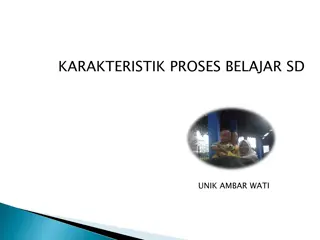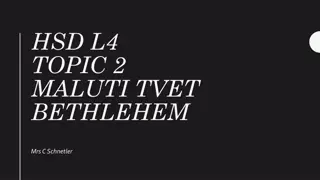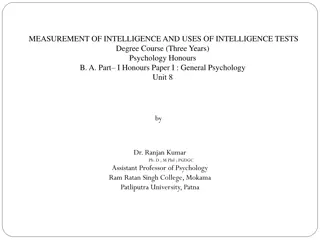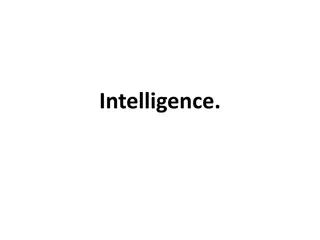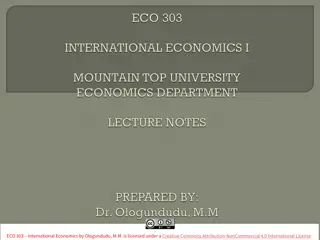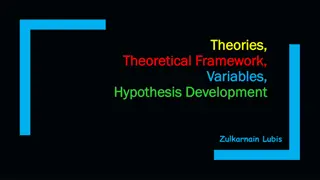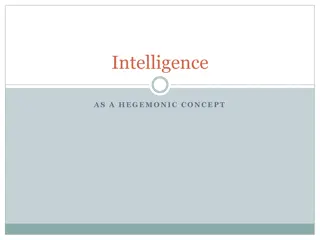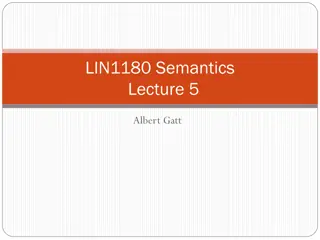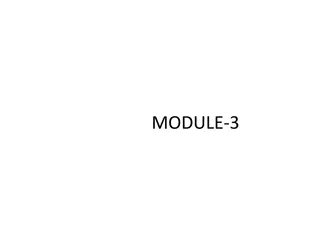Understanding Intelligence: Theories and Types Explored
Intelligence is the global capacity to comprehend the world, think logically, and utilize resources effectively. This content delves into the nature of intelligence, explaining intelligent behavior and discussing different types of intelligence such as verbal comprehension, spatial visualization, and more. Theories by Robert Sternberg and Howard Gardner further dissect intelligence into different forms and types, emphasizing analytical, creative, and practical aspects. Explore the diverse facets of intelligence to gain a deeper understanding of this fascinating concept.
Download Presentation

Please find below an Image/Link to download the presentation.
The content on the website is provided AS IS for your information and personal use only. It may not be sold, licensed, or shared on other websites without obtaining consent from the author. Download presentation by click this link. If you encounter any issues during the download, it is possible that the publisher has removed the file from their server.
E N D
Presentation Transcript
E-content Psychology, Semester 1, Unit 3 Intelligence: Nature & theories By Naureen Naseer Asst. Prof GDC, Ganderbal
To understand the concept of intelligence Explain what constitutes intelligent behaviour Understand different types of intelligence
Intelligence is the global capacity to understand the world, think rationally, and use available resources effectively when faced with challenges. It refers to individual abilities to understand complex ideas, to adapt effectively to the environment, to learn from experience, to engage in various forms of reasoning, to overcome obstacles by careful thought.
Intelligence is an aggregate of relatively independent attitudes as: Verbal comprehension Word fluency Skills in numerical computation Perceptual speed and accuracy Associative memory Spatial visualization Mechanical engineering
Robert Sternberg in 1985, proposed an important theory of intelligence known as triarchic theory of intelligence. The theory suggests there are three basic forms of intelligence: 1.Componential or analytic intelligence: It involves the abilities to think critically and analytically. 2.Experiential or creative intelligence: It emphasizes insight and the ability to formulate new ideas. 3.Contextual or practical intelligence: It is the intelligence that is useful in solving everyday problems.
Howard intelligences.He believes intelligence is not a single entity, rather eight distinct types of intelligences exist, namely: Gardner (1983) proposed the theory of multiple 1.Verbal-Linguistic: It includes skills involved in the production and use of language. 2.Logical-Mathematical: It includes skills in scientific thinking and problem solving. 3.Spatial: It includes skills in forming visual images and patterns. 4.Musical: It includes sensitivity to musical rhythms and patterns.
5.Bodily-Kinaesthetic: It involves using whole or portions of the body flexibly and creatively. 6.Interpersonal: It includes sensitivity to subtle aspects of others behaviours. 7.Intrapersonal: It includes awareness of one s own feelings, motives, and desires. 8.Naturalistic: It includes sensitivity to the features of the natural world
The English psychologist, Charles Spearman, in 1904 proposed his theory of intelligence called two-factor theory. According to him, intellectual abilities are comprised of two factors, namely the general ability known as G-factor the specific abilities known as S-factor
1.It is universal inborn ability. 2.It is general mental energy. 3.It is constant. 4.The amount of g differs from individual to individual. It is used in every activity of life. 5.Greater the g in an individual, greater is his success in life.
1. It is learned and acquired in the environment. 2. It varies from activity to activity in the same individual. 3. Individuals differ in the amount of S ability.
Intelligence understand the world, think rationally, and use resources effectively to meet the demands of life. Sternberg s triarchic theory describes the processes underlying intelligent behaviour. Howard Gardner suggests that there are eight different kinds of intelligence. Charles Spearman suggests intelligence has two factors: g-factor and s-factor. refers to an capacity to individual s
1. What is the concept of intelligence? 2. How would you explain the nature of intelligence? 3.Explain briefly the multiple intelligences identified by Gardner. 4. How does the triarchic theory help us to understand intelligence?


